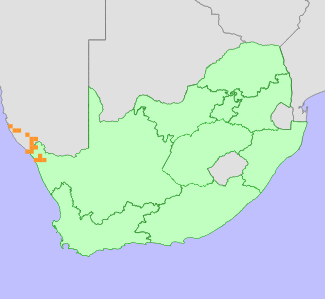|
Scientific Name | Lapeirousia barklyi Baker |
Higher Classification | Monocotyledons |
Family | IRIDACEAE |
National Status |
Status and Criteria | Endangered A3c+4ac |
Assessment Date | 2022/12/07 |
Assessor(s) | D. Raimondo, N.A. Helme & P.C.V. Van Wyk |
Justification | An endemic to the Sperrgebiet and Richtersveld regions of Namibia and South Africa, this species has a small geographic range. Its habitat is declining due to mining and livestock overgrazing. Between 10 and 20% of the South African population has been lost since 2002. A further 50 to 60% will be lost by 2032 as a result of the planned Bogoebaai Port and Green Hydrogen Strategic Economic Development Project. This species therefore qualifies for listing as Endangered under criterion A. While the population is continuous with Namibia, the population in Namibia is also declining due to mining, and there are also plans for a second green hydrogen project in Namibia. The regional status is therefore not downgraded. |
Distribution |
Endemism | Not endemic to South Africa |
Provincial distribution | Northern Cape |
Range | It occurs in coastal areas of southern Namibia and the Northern Cape (South Africa) between Lüderitz and Kleinsee. |
Habitat and Ecology |
Major system | Terrestrial |
Major habitats | Richtersveld Coastal Duneveld, Northern Richtersveld Scorpionstailveld, Lekkersing Succulent Shrubland, Upper Annisvlakte Succulent Shrubland, Southern Richtersveld Scorpionstailveld, Western Gariep Hills Desert, Western Gariep Lowland Desert, Namaqualand Riviere |
Description | This species grows on sandy flats near the coast. |
Threats |
| Threatened by severe, ongoing habitat loss and degradation resulting from open-cast mining along the coast between Alexander Bay and Kleinsee, and also inland along the lower Gariep Valley to Sendelingsdrif. Subpopulations on the western plains of the Richtersveld are also threatened by habitat degradation and trampling as a result of severe overstocking of communal rangelands, which has led to a loss of shrub cover, plant species diversity and erosion. The Boegoebaai Port development project being planned for implementation over the next 10 years, which will include the construction of a port for deep sea vessels, railway line and several refineries for oil and other minerals as well as extensive renewable energy facilities to power a green hydrogen plant, is suspected to result in ongoing habitat loss. |
Population |
In South Africa, this species has a limited distribution and is declining across its range, between 10 and 20% of the population is inferred to have been lost since 2002 due to mining and livestock overgrazing. It is more widespread and common in Namibia. At least half of the subpopulations that have been recorded in South Africa fall within the proposed development footprint for the Bogoebaai, green hydrogen strategic economic development zone. This development is likely to cause between 50 and 60% of the South Africa's portion of the population to be lost by 2032.
|
Population trend | Decreasing |
Assessment History |
Taxon assessed |
Status and Criteria |
Citation/Red List version | | Lapeirousia barklyi Baker | NT* B1ab(iii,v) | 2015.1 | | Lapeirousia barklyi Baker | Least Concern | Raimondo et al. (2009) | | Lapeirousia barklyi Baker | Not Threatened | Hilton-Taylor (1996) | |
Bibliography |
Hilton-Taylor, C. 1996. Red data list of southern African plants. Strelitzia 4. South African National Botanical Institute, Pretoria.
Raimondo, D., von Staden, L., Foden, W., Victor, J.E., Helme, N.A., Turner, R.C., Kamundi, D.A. and Manyama, P.A. 2009. Red List of South African Plants. Strelitzia 25. South African National Biodiversity Institute, Pretoria.
Snijman, D.A. 2013. Plants of the Greater Cape Floristic Region 2: The extra Cape flora. Strelitzia 30. South African National Biodiversity Institute, Pretoria.
|
Citation |
| Raimondo, D., Helme, N.A. & Van Wyk, P.C.V. 2022. Lapeirousia barklyi Baker. National Assessment: Red List of South African Plants version 2024.1. Accessed on 2025/12/02 |
 Comment on this assessment
Comment on this assessment


